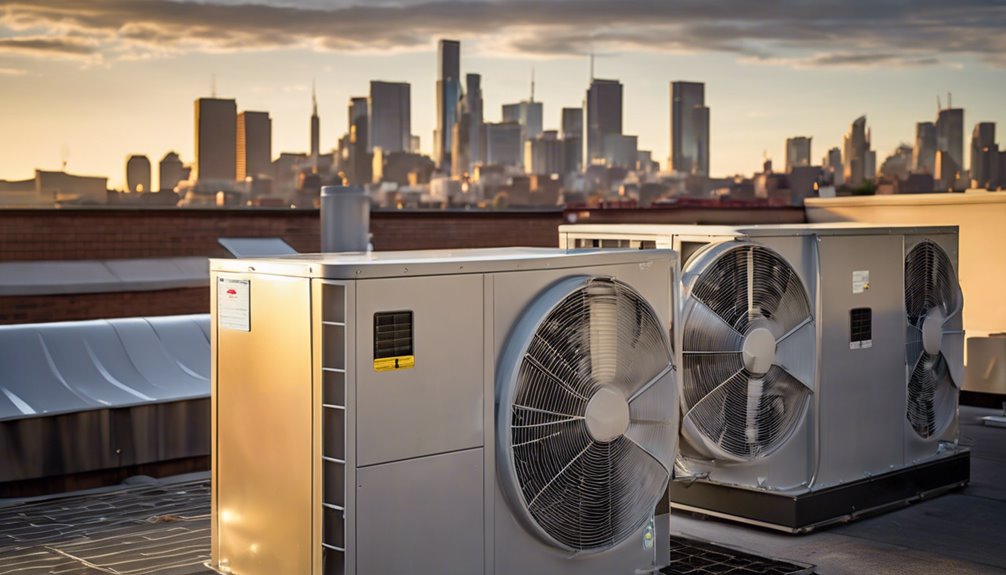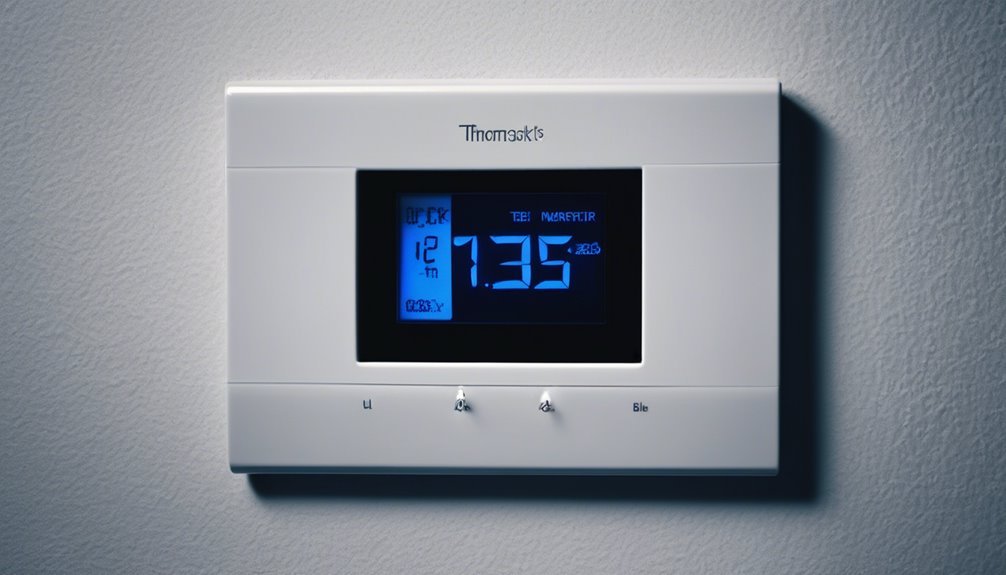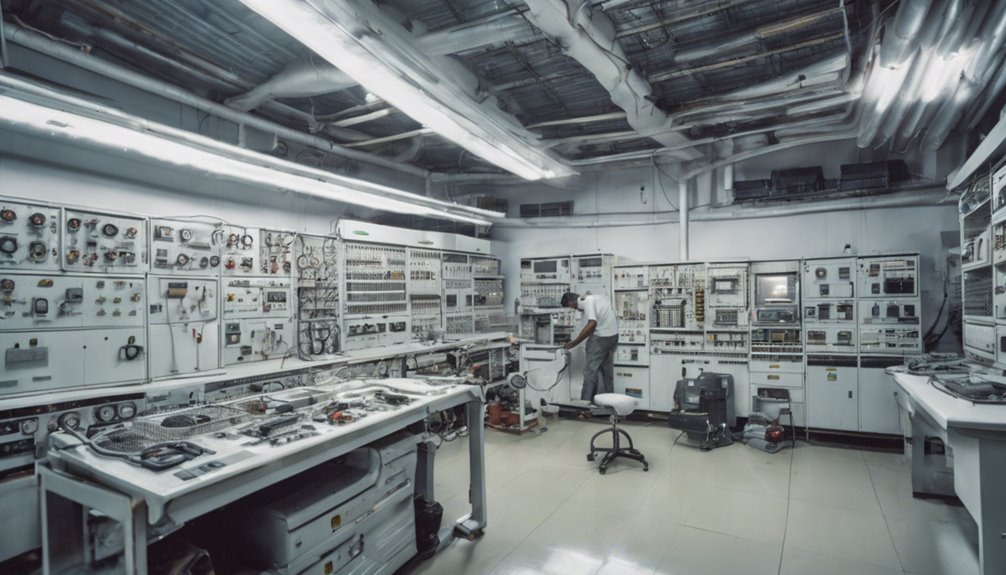Your air conditioner's energy efficiency has a significant impact on your wallet and the environment, with a higher Seasonal Energy Efficiency Ratio (SEER) rating translating to lower energy bills and a reduced carbon footprint. By understanding the factors that affect energy consumption, optimizing cooling capacity, and maintaining your AC regularly, you can enjoy cost savings and a longer-lasting system. Plus, making a few simple tweaks can further boost energy efficiency – and there's more to explore to maximize your AC's performance.
Key Takeaways
- A higher SEER rating indicates higher energy efficiency, leading to significant cost savings and reduced energy consumption.
- Proper AC sizing, regular maintenance, and filter cleaning are crucial for optimal performance and energy efficiency.
- Thermostat settings can be optimized for energy efficiency by adjusting the temperature based on occupancy, time of day, and schedule.
- Clearing clutter near vents, using zone control, and upgrading to high-flow vents can enhance energy efficiency and airflow.
- Energy-efficient AC systems reduce energy consumption, lower energy bills, and extend the AC's lifespan, while also improving air quality and circulation.
Understanding the Link Between Energy Efficiency and AC Performance
When it comes to air conditioning, you might assume that energy efficiency and AC performance are mutually exclusive – that is, you can either have an energy-efficient unit or a high-performing one, but not both.
However, modern cooling technologies have bridged this gap, allowing you to enjoy both benefits simultaneously.
For instance, advanced fan designs and improved compressor technology enable ACs to cool more efficiently while maintaining high performance.
Additionally, these advancements also contribute to better air quality by reducing pollutants and allergens.
Factors Affecting Your AC's Energy Consumption
Now that you've got the benefits of energy-efficient ACs, it's time to get down to business and understand what drives your unit's energy consumption.
Your cooling habits play a significant role in how much energy your AC uses. For instance, if you're in the habit of cranking up the thermostat to cool your space quickly, you're likely consuming more energy than necessary.
Additionally, the placement of your AC unit affects its performance. If it's placed in a sunny spot or near heat-producing appliances, it'll have to work harder to cool your space, resulting in higher energy consumption.
The Role of SEER Ratings in Energy Efficiency
When shopping for a new air conditioner, you'll likely come across the SEER rating, a crucial factor in determining energy efficiency.
But what does this rating really mean, and how can it impact your energy bills?
Understanding the SEER rating is key to making an informed decision that can save you money in the long run.
SEER Rating Explained
Your air conditioner's SEER rating plays a significant role in determining its energy efficiency and overall performance.
It's essential to understand what this rating means and how it affects your AC's operation. SEER stands for Seasonal Energy Efficiency Ratio, which measures an air conditioner's ability to cool your home efficiently.
SEER standards are set by the U.S. Department of Energy, and they require AC manufacturers to test their products according to specific cooling metrics. These metrics include the total amount of cooling provided during a typical season and the total electricity consumed during that same period.
A higher SEER rating indicates that your AC is more energy-efficient and can help you save money on your energy bills.
Higher Is Better?
The SEER rating's importance in determining an air conditioner's energy efficiency can't be overstated, but it raises a crucial question: is a higher SEER rating always better?
You might think so, but it's not always the case. While a higher SEER rating generally means better energy efficiency, it's essential to consider your specific cooling needs and circumstances.
For instance, if you live in an area with mild summers, a higher SEER rating mightn't be necessary. Additionally, some cooling myths can lead to misconceptions about energy literacy.
- You live in an area with low energy costs.
- Your AC unit is relatively small.
- You're on a tight budget and prioritize upfront cost over long-term savings.
Impact on Bills
A higher SEER rating can significantly impact your energy bills, and understanding this relationship is crucial for making informed decisions.
When you invest in an air conditioner with a higher SEER rating, you can expect significant cost savings over time. This is because a higher SEER rating indicates that the AC is more energy-efficient, consuming less power to cool your home.
As a result, you'll see a noticeable bill reduction, which can add up to substantial savings over the course of a year. In fact, according to the US Department of Energy, upgrading to a high-efficiency AC can save you up to $200 annually on your energy bills.
Optimizing Your AC's Cooling Capacity
Since you're already investing in an air conditioner, it's only sensible to maximize its cooling capacity.
Don't fall for common cooling myths – AC sizing is crucial to optimizing performance.
- Room size: Measure your room's square footage to determine the required cooling capacity.
- Insulation and windows: Consider the number and size of windows, as well as the insulation quality, to adjust the AC's power accordingly.
- Occupancy and appliances: Factor in the number of people and heat-producing appliances in the room to ensure your AC can handle the load.
The Importance of Regular Maintenance and Servicing
Now that you've got the right-sized AC, it's time to ensure it runs efficiently and effectively. Regular maintenance and servicing are crucial to achieve this. By doing so, you'll prevent breakdowns, reduce energy consumption, and prolong your AC's lifespan.
| Task | Frequency | Importance |
|---|---|---|
| System checks | Quarterly | High |
| Filter cleaning | Monthly | Medium |
| Coil cleaning | Bi-annually | High |
When choosing a technician, look for certification from a reputable organization. A certified technician will ensure your AC is serviced correctly, and you'll get the most out of your maintenance efforts. Remember, a well-maintained AC is an efficient AC, and that's crucial for your wallet and the environment.
Enhancing Airflow for Better Energy Efficiency
How can you optimize your AC's performance without breaking the bank?
One often overlooked aspect is enhancing airflow, which can significantly impact energy efficiency.
Proper air distribution and ventilation design are crucial to ensure your AC operates at its best.
- Clear the clutter: Make sure there are no obstructions near vents and air intakes, as this can restrict airflow and reduce efficiency.
- Use zone control: Divide your space into zones and adjust airflow accordingly, so you're not wasting energy cooling areas that don't need it.
- Upgrade to high-flow vents: Replace standard vents with high-flow ones to increase airflow and reduce pressure drops.
Smart Thermostats and Energy-Saving Features
Your air conditioner's performance can be optimized with the help of smart thermostats, which offer advanced energy-saving features that go beyond traditional temperature control.
These thermostats can learn your schedule and preferences to adjust the temperature accordingly, saving you energy and money. You can also control them remotely through your smartphone, ensuring your home is comfortable when you arrive.
Smart home thermostat integration allows you to connect your thermostat with other devices, such as lights and security systems, for a seamless experience.
Simple Tweaks for a More Energy-Efficient AC System
You can boost your AC's energy efficiency with a few simple tweaks.
Start by cleaning your air filters regularly, as dirty filters can increase your energy consumption by up to 15%.
Additionally, optimize your smart thermostat settings to ensure your AC is working at its best.
Clean Air Filters
Dirty air filters are a common culprit when it comes to an inefficient air conditioning system, and they can increase your energy bills and reduce the overall performance of your AC.
By neglecting to replace them regularly, you're allowing dust, dirt, and other particles to circulate in the air, compromising air quality and making your AC work harder.
- Improved air quality: Clean filters capture pollutants and allergens, ensuring the air you breathe is fresh and healthy.
- Increased energy efficiency: A clean filter reduces the load on your AC, allowing it to cool your space more efficiently and reducing your energy bills.
- Prolonged AC lifespan: Regular filter replacements prevent dust and dirt from accumulating in your AC's internal components, extending its lifespan and reducing the need for costly repairs.
Smart Thermostat Settings
The key to unlocking a more energy-efficient air conditioning system lies in the humble thermostat.
You can optimize your thermostat's settings to minimize energy waste and save on your utility bills. For instance, you can program your thermostat to follow a summer schedule, where it automatically adjusts the temperature when you're not home or when you're sleeping.
Additionally, consider investing in a smart thermostat with Geofencing capabilities, which can detect when you're approaching or leaving your home and adjust the temperature accordingly.
Frequently Asked Questions
Can I Use a Programmable Thermostat With My Existing AC System?
You can likely use a programmable thermostat with your existing AC system, but first, check the thermostat's compatibility with your system's specific make and model to ensure seamless integration and avoid any installation headaches.
How Often Should I Replace My Air Conditioner's Air Filters?
You should replace your air conditioner's air filters every 1-3 months, depending on filter quality and usage. Regular filter maintenance is crucial, as dirty filters increase energy bills and reduce airflow, making your AC work harder.
Does Using a Ceiling Fan Really Help Reduce AC Energy Consumption?
You're wondering if running a ceiling fan really makes a difference. Yes, it can! By spinning counterclockwise in Summer mode, the fan creates a cooling breeze, allowing you to raise your AC's thermostat, which ultimately reduces energy consumption.
Can I Install a Smart Thermostat Myself or Do I Need a Pro?
You can try installing a smart thermostat yourself, but be aware of DIY challenges like wiring and compatibility issues. Ensure your thermostat is compatible with your HVAC system to avoid headaches, or consider hiring a pro for a hassle-free install.
Do Energy-Efficient ACS Really Make a Significant Difference in Bills?
You wonder if energy-efficient ACs really make a dent in your bills. The answer is yes! Look for Energy Star ratings, which guarantee Seasonal savings of up to 15% on cooling costs, translating to significant long-term savings.
Conclusion
You've now got the lowdown on how to maximize your AC's energy efficiency and performance. By choosing the right SEER-rated unit, optimizing cooling capacity, and maintaining your system, you'll be well on your way to saving energy and cash. Don't forget to enhance airflow, invest in a smart thermostat, and make those simple tweaks to get the most out of your AC. With these tips, you'll be breathing easy – and so will your wallet!



